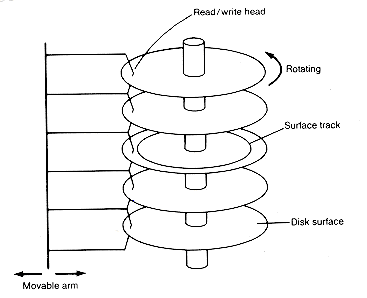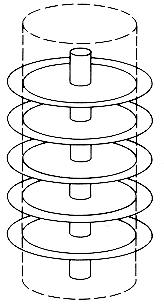A random access memory allows very fast access to any element of the memory. The access time is the same for all stored elements, no matter which element was last accessed. Sequential devices allow fast access "locally," but all elements between the currently accessed element and the next desired element must be passed through before the next element may be accessed. Consequently, the time to access the next desired element is proportional to its distance from the currently accessed element. Direct access devices are intermediate between these two extremes. They act like sequential devices with tabs. Just as using the alphabetical tabs in a dictionary allows a person seeking a word to find it quickly, so do "tabs" allow one to close in, relatively quickly, on the desired area of the sequential storage. In direct access devices, the "tabs" are the movable read/write heads.
Sequential devices are convenient for tasks that may be accomplished by traversing records. However, when the order in which the records must be processed cannot be predicted, sequential access devices are not efficient. Tasks requiring random access to records cannot be accomplished efficiently using sequential memory devices. The introduction of economical direct access devices made random access feasible. As a result, airline reservation systems, interactive computing, and instant updating of bank accounts have become commonplace. This was made possible by the development of appropriate technology for direct access memory.
A magnetic disk is a flat, circular platter on whose surfaces information can be stored and accessed. It can be pictured as a phonograph tone arm and record, with its concentric tracks corresponding to the grooves of the phonograph record and its movable read/write head corresponding to the tone arm. A disk pack consists of a pile of such magnetic disks and a read/write head for each record surface?/FONT>that is, one head for each side of a record (see Figure 10.7). The read/ write heads are typically coupled so that they all move at the same time. They are positioned over the same track on their respective surfaces, although only one head is actually reading or writing at any moment. There may be twenty magnetic disks and a hundred tracks on each disk.
Each track of a surface in a disk pack stores records in blocks, similar to the blocking of records on magnetic tapes. Each track behaves as a sequential access device, like a magnetic tape. That is, each block must be passed through, as the disks rotate, before another block farther along the track can be accessed by the surface read/write head.
If we focus on the same track on each surface, then the pile of tracks forms a conceptual cylinder in space, as shown in Figure 10.8. Assuming tracks are numbered (say, from 1 to 100), a cylinder consists of all tracks with the same number. Thus the disk pack can be viewed as composed of one hundred concentric cylinders.
A cylinder is important because it allows any block of records stored on a surface of the cylinder to be accessed without moving the read/write heads. Accessing a block stored on a different cylinder (or track) requires moving the read/write heads. The time required to move the heads from one cylinder to another is called seek time; it is proportional to the distance between the cylinders. This time typically takes a significant fraction of a second (1/10th to 1/20th). It is the dominant factor in dealing with time requirements for accessing blocks on magnetic disks.
Once the read/write heads are positioned over the desired cylinder, the time required for the desired block to rotate under the heads is called latency time. It can be on the order of one hundredth of a second.

Figure 10.7 A Disk Pack

Figure 10.8 Conceptual Cylinder